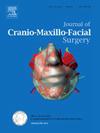颞下颌关节积液MRI与Wilkes分期、关节镜检查结果和颞下颌关节疾病滑膜液生物标志物的相关性
IF 2.1
2区 医学
Q2 DENTISTRY, ORAL SURGERY & MEDICINE
引用次数: 0
摘要
磁共振成像(MRI)提高了对颞下颌关节(TMJ)疾病的认识,特别是在检测结构变化和积液方面。本研究旨在探讨颞下颌关节积液、Wilkes分期、关节镜检查结果和滑液生物标志物之间的关系。回顾性分析2008年至2022年接受关节镜检查的93例(109例)MRI显示TMJ积液患者的临床资料。纳入的患者对保守治疗难治性,经MRI确诊为颞下颌紊乱,按Wilkes分期进行分类。收集关节镜下发现的数据,包括滑膜炎、软骨软化、粘连和椎间盘穿孔,并对滑膜液样本进行生化分析。结果显示,积液与较高的Wilkes分期呈正相关,表明关节受累程度较高,年龄、软骨软化症和滑膜炎之间存在显著关系。年龄与软骨病和疾病严重程度显著相关,而滑膜炎与软骨病和Wilkes分期均有很强的相关性,表明炎症进展。软骨软化症患者的滑膜蛋白浓度升高,提示与关节变性有关,而炎症患者的葡萄糖水平趋于降低。钠、钾和氯化物水平在各个阶段都是稳定的。关节镜可以精确显示颞下颌关节病变,支持其在严重颞下颌疾病中的诊断和治疗价值。本研究强调了积液作为晚期TMJ退变的潜在标志,强调了对关节炎症患者进行早期诊断和靶向治疗的必要性。本文章由计算机程序翻译,如有差异,请以英文原文为准。
Correlation of temporomandibular joint effusion on MRI with Wilkes staging, arthroscopic findings, and synovial fluid biomarkers in temporomandibular disorders
Magnetic resonance imaging (MRI) has advanced the understanding of temporomandibular joint (TMJ) disorders, particularly in detecting structural changes and effusion. This study aims to explore the relationship between TMJ effusion, Wilkes staging, arthroscopic findings, and synovial fluid biomarkers. Clinical data from 93 patients (109 TMJs) with TMJ effusion on MRI who underwent arthroscopy from 2008 to 2022 were reviewed retrospectively. Patients included were refractory to conservative treatments, had a diagnosis of temporomandibular disorder confirmed by MRI, and were classified according to Wilkes stages. Data were collected on arthroscopic findings, including synovitis, chondromalacia, adhesions, and disc perforations, and biochemical analysis was performed on synovial fluid samples. Results showed that effusion positively correlated with higher Wilkes stages, indicating advanced joint involvement and significant relationships between age, chondromalacia, and synovitis. Age correlated significantly with chondromalacia and disease severity, while synovitis showed a strong correlation with both chondromalacia and Wilkes stage, indicating progression with inflammation. Synovial protein concentrations were elevated in cases with chondromalacia, suggesting a link with joint degeneration, while glucose levels tended to decrease in inflammatory cases. Sodium, potassium, and chloride levels were stable across stages. Arthroscopy allowed precise visualization of TMJ pathologies, supporting its diagnostic and therapeutic value in severe temporomandibular disorders. This study highlights effusion as a potential marker of advanced TMJ degeneration, emphasizing the need for early diagnosis and targeted treatment in patients with joint inflammation.
求助全文
通过发布文献求助,成功后即可免费获取论文全文。
去求助
来源期刊
CiteScore
5.20
自引率
22.60%
发文量
117
审稿时长
70 days
期刊介绍:
The Journal of Cranio-Maxillofacial Surgery publishes articles covering all aspects of surgery of the head, face and jaw. Specific topics covered recently have included:
• Distraction osteogenesis
• Synthetic bone substitutes
• Fibroblast growth factors
• Fetal wound healing
• Skull base surgery
• Computer-assisted surgery
• Vascularized bone grafts

 求助内容:
求助内容: 应助结果提醒方式:
应助结果提醒方式:


